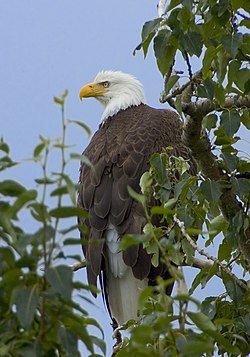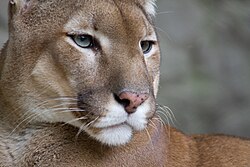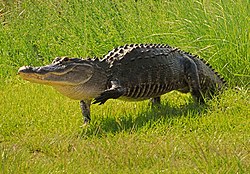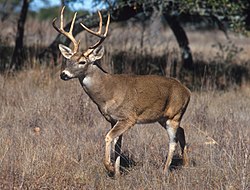| Common name | Binomial name | Family | Image | Distribution area | Notes |
|---|
| ABC Islands bear | Ursus arctos sitkensis | Ursidae |  | ABC Islands | |
| Abert's squirrel | Sciurus aberti | Sciuridae |  | Western United States | |
| Agile kangaroo rat | Dipodomys agilis | Heteromyidae |  | South California | |
| Alaska marmot | Marmota broweri | Sciuridae |  | Alaska | |
| Alaska Peninsula brown bear | Ursus arctos gyas | Ursidae |  | Alaska Peninsula | |
| Alaska tiny shrew | Sorex yukonicus | Soricinae | | Alaska | |
| Alaskan hare | Lepus othus | Leporidae |  | Alaska | |
| Alaskan tundra wolf | Canis lupus tundrarum | Canidae |  | Arctic Alaska | |
| Allen's big-eared bat | Idionycteris phyllotis | Vespertilionidae |  | mainly in Arizona; has been spotted in California, Colorado, Nevada, New Mexico, Utah | |
| American badger | Taxidea taxus | Mustelidae |  | Across the country except Alaska, Hawaii, New England Puerto Rico, Southern United States (excluding Texas) and the U.S. Virgin Islands | The Wisconsin state mammal |
| American bison | Bison bison | Bovidae |  | Alaska, Arizona and Montana | The Kansas, Oklahoma and Wyoming state mammal; the US national mammal |
| American black bear | Ursus americanus | Ursidae |  | Across the country except Hawaii, Puerto Rico and the U.S. Virgin Islands | The Alabama, Louisiana, New Mexico and West Virginia state mammal |
| American ermine | Mustela richardsonii | Mustelidae |  | Northeastern and Western United States | |
| American marten | Martes americana | Mustelidae |  | Across the country except Hawaii, Puerto Rico, Southwestern United States, Texas and the U.S. Virgin Islands | |
| American mink | Neogale vison | Mustelidae |  | Alaska, Michigan, New England, New York, Wisconsin | |
| American pika | Ochotona princeps | Ochotonidae |  | Western United States | |
| American pygmy shrew | Sorex hoyi | Soricinae |  | Alaska, the Appalachians, the Great Lakes, New England, the Rockies | |
| American red fox | Vulpes vulpen fulva | Canidae |  | Eastern United States | |
| American red squirrel | Tamiasciurus hudsonicus | Sciuridae |  | Alaska, Northeastern United States and the Rockies | |
| American shrew mole | Neurotrichus gibbsii | Talpinae |  | Pacific Coast | The smallest species of mole |
| American water shrew | Sorex palustris | Soricinae |  | Alaska, the Appalachians, Illinois, Michigan, Minnesota, New England, Western United States | The smallest mammalian diver |
| Antelope jackrabbit | Lepus alleni | Leporidae |  | Southern Arizona | |
| Antillean fruit-eating bat | Brachyphylla cavernarum | Mormoopidae | | Puerto Rico, U.S. Virgin Islands | |
| Antillean ghost-faced bat | Mormoops blainvillei | Phyllostomidae | | Puerto Rico | |
| Antillean manatee | Trichechus manatus manatus | Trichechidae |  | Puerto Rico | The largest sea cow species |
| Appalachian cottontail | Sylvilagus obscurus | Leporidae |  | The Appalachians | |
| Arctic fox | Vulpes lagopus | Canidae |  | Alaska | |
| Arctic ringed seal | Pusa hispida hispida | Phocidae |  | Alaska, New England | The most abundant and wide-ranging seal in the Northern Hemisphere |
| Arctic shrew | Sorex arcticus | Soricinae |  | Northern United States | |
| Arizona gray squirrel | Sciurus arizonensis | Sciuridae |  | Arizona | |
| Arizona myotis | Myotis occultus | Vespertilionidae | | Southwestern United States | |
| Arizona pocket mouse | Perognathus amplus | Heteromyidae | | Sonoran Desert | |
| Arizona shrew | Sorex arizonae | Soricinae | | Arizona, New Mexico | |
| Atlantic white-sided dolphin | Lagenorhynchus acutus | Delphinidae |  | New England | |
| Attwater's pocket gopher | Geomys attwateri | Geomyidae |  | Texas Coastal Bend | |
| Avery Island white-tailed deer | Odocoileus virginianus mcilhennyi | Cervidae | | Louisiana and South Texas | |
| Atlantic spotted dolphin | Stenella frontalis | Delphinidae |  | East Coast | |
| Bailey's pocket mouse | Chaetodipus baileyi | Heteromyidae |  | Arizona, California, New Mexico | |
| Baird's beaked whale | Berardius bairdii | Ziphiidae |  | West Coast | |
| Baird's pocket gopher | Geomys breviceps | Geomyidae |  | Arkansas, East Texas, Louisiana, Oklahoma | |
| Baird's shrew | Sorex bairdi | Soricinae |  | Oregon | |
| Baja pocket mouse | Chaetodipus rudinoris | Heteromyidae | | Southern California and the Channel Islands | |
| Banner-tailed kangaroo rat | Dipodomys spectabilis | Heteromyidae |  | Southwestern United States | |
| Barren ground shrew | Sorex ugyunak | Soricinae | | Alaska | |
| Bearded seal | Erignathus barbatus | Phocidae |  | Alaska | |
| Beech marten | Martes foina | Mustelidae |  | Wisconsin (introduced) | |
| Beluga whale | Delphinapterus leucas | Monodontidae |  | Alaska | |
| Beringian lemming | Lemmus nigripes | Cricetidae |  | Alaska | |
| Big brown bat | Eptesicus fuscus | Vespertilionidae |  | Contiguous United States | The District of Columbia state mammal |
| Big free-tailed bat | Nyctinomops macrotis | Molossidae |  | California, Nevada, Texas, Utah | |
| Blackbeard Island white-tailed deer | Odocoileus virginianus nigribarbis | Cervidae | | Blackbeard Island National Wildlife Refuge | |
| Black-footed ferret | Mustela nigripes | Mustelidae |  | Western United States | |
| Black-tailed jackrabbit | Lepus californicus | Leporidae | 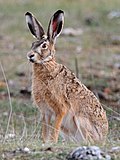 | Great Plains, Western and West North Central states; introduced in Maryland, New Jersey, and Virginia | |
| Black-tailed prairie dog | Cynomys ludovicianus | Sciuridae |  | Montana, North Dakota, South Dakota, Wyoming, Colorado, Nebraska, Kansas, Oklahoma, Texas, Arizona, and New Mexico | |
| Blainville's beaked whale | Mesoplodon densirostris | Ziphiidae |  | East and West Coast of the United States | |
| Blue whale | Balaenoptera musculus | Balaenopteridae |  | East and West Coast of the United States | |
| Bobcat | Lynx rufus | Felidae |  | Contiguous United States | The New Hampshire state wildcat |
| Botta's pocket gopher | Thomomys bottae | Geomyidae |  | Southwestern United States | |
| Bowhead whale | Balaena mysticetus | Balaenidae |  | Alaska | The Alaska state marine mammal |
| British Columbia red fox | Vulpes vulpen abietorum | Canidae |  | Alaskan Panhandle | |
| British Columbia wolf | Canis lupus columbianus | Canidae | 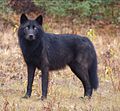 | Alaskan Panhandle, Alexander Archipelago | |
| Brush rabbit | Sylvilagus bachmani | Leporidae |  | The West Coast | |
| Bryde's whale | Balaenoptera brydei | Balaenopteridae |  | South Atlantic and Gulf of Mexico | |
| Bulls Island white-tailed deer | Odocoileus virginianus taurinsulae | Cervidae |  | Cape Romain National Wildlife Refuge | |
| California kangaroo rat | Dipodomys californicus | Heteromyidae | | California, Oregon | |
| California sea lion | Zalophus californianus | Otariidae |  | West Coast | |
| Camas pocket gopher | Thomomys bulbivorus | Geomyidae |  | Willamette Valley | |
| Canadian lemming | Lemmus trimucronatus | Cricetidae |  | Alaska | |
| Canadian lynx | Lynx canadensis | Felidae |  | Alaska, Colorado, Idaho, Maine, Minnesota, Montana, Utah, Washington | |
| Canyon bat | Parastrellus hesperus | Vespertilionidae |  | Western United States | The smallest bat in the United States |
| Carabao | Bubalus bubalis kerabau | Bovidae |  | Guam | |
| Cave myotis | Myotis velifer | Vespertilionidae |  | Arizona, Kansas, Oklahoma, Texas | |
| Cascade golden-mantled ground squirrel | Callospermophilus saturatus | Sciuridae | 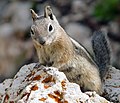 | The Cascades | |
| Cascade red fox | Vulpes vulpen cascadensis | Canidae |  | Washington | |
| California leaf-nosed bat | Macrotus californicus | Phyllostomidae |  | Sonoran and Mojave deserts | |
| California mule deer | Odocoileus hemionus californicus | Cervidae |  | California | |
| California myotis | Myotis californicus | Vespertilionidae |  | Western United States | |
| California pocket mouse | Chaetodipus californicus | Heteromyidae |  | Southern California | |
| California vole | Microtus californicus | Cricetidae |  | California and Oregon | |
| Carmen Mountains white-tailed deer | Odocoileus virginianus carminis | Cervidae |  | South Texas | |
| Central Texas pocket gopher | Geomys texensis | Geomyidae | | Central Texas | |
| Chihuahuan pocket mouse | Chaetodipus eremicus | Heteromyidae |  | Southwestern United States | |
| Chisel-toothed kangaroo rat | Dipodomys microps | Heteromyidae |  | Arizona, California, Idaho, Nevada, Oregon, Utah | |
| Cinereus shrew | Sorex cinereus | Soricinae |  | Alaska, Northern United States, Northwestern United States | The most widely distributed shrew in North America |
| Clymene dolphin | Stenella clymene | Delphinidae |  | East Coast | |
| Coast mole | Scapanus orarius | Scalopinae |  | Pacific Northwest | |
| Cockrum's gray shrew | Notiosorex cockrumi | Soricinae |  | Arizona | |
| Collared peccary | Dicotyles tajacu | Tayassuidae |  | Arizona, New Mexico and Texas | |
| Collared pika | Ochotona collaris | Ochotonidae |  | Alaska | |
| Columbian black-tailed deer | Odocoileus hemionus columbianus | Cervidae |  | Kauai, Pacific Northwest | |
| Columbian white-tailed deer | Odocoileus virginianus leucurus | Cervidae |  | Oregon, Washington | |
| Common bottlenose dolphin | Tursiops truncatus | Delphinidae |  | East and California | The Florida and South Carolina state salt water mammal |
| Common dolphin | Delphinus delphis | Delphinidae |  | East and California | |
| Common minke whale | Balaenoptera acutorostrata | Balaenopteridae |  | East and West Coast of the United States | |
| Coues' white-tailed deer | Odocoileus virginianus couesi | Cervidae |  | Arizona | |
| Cougar | Puma concolor | Felidae |  | Western United States | The most widely distributed wild, terrestrial mammal in the Western Hemisphere |
| Coyote | Canis latrans | Canidae |  | Across the country | The South Dakota state mammal |
| Crawford's gray shrew | Notiosorex crawfordi | Soricinae |  | Southwestern United States | |
| Creeping vole | Microtus oregoni | Cricetidae |  | Pacific Northwest | |
| Cuvier's beaked whale | Ziphius cavirostris | Ziphiidae |  | East and West Coast of the United States | |
| Dakota white-tailed deer | Odocoileus virginianus dacotensis | Cervidae |  | Colorado, the Dakotas, Minnesota, Montana, Wyoming | |
| Dall Island black bear | Ursus americanus pugnax | Ursidae | | Dall Island | |
| Dall Island brown bear | Ursus arctos dalli | Ursidae | | Dall Island | |
| Dall sheep | Ovis dalli dalli | Bovidae |  | Alaska | |
| Dall's porpoise | Phocoenoides dalli | Phocoenidae |  | West Coast of the United States | |
| Dark kangaroo mouse | Microdipodops megacephalus | Heteromyidae | | California and Nevada | |
| Desert bighorn sheep | Ovis canadensis nelsoni | Bovidae |  | Southwestern United States | The Nevada state mammal |
| Desert cottontail | Sylvilagus audubonii | Leporidae |  | Western United States | |
| Desert kangaroo rat | Dipodomys deserti | Heteromyidae |  | Southwestern United States | |
| Desert mule deer | Odocoileus hemionus eremicus | Cervidae |  | Southwestern United States | |
| Desert pocket gopher | Geomys arenarius | Geomyidae |  | New Mexico, Texas | |
| Desert pocket mouse | Chaetodipus penicillatus | Heteromyidae |  | Southwestern United States | |
| Douglas squirrel | Tamiasciurus douglasii | Sciuridae |  | Western United States | |
| Dugong | Dugong dugon | Dugongidae |  | The Northern Mariana Islands | |
| Dulzura kangaroo rat | Dipodomys simulans | Heteromyidae |  | California | |
| Dwarf shrew | Sorex nanus | Soricinae | | Mountain States | |
| Dwarf sperm whale | Kogia sima | Kogiidae |  | East and West Coast of the United States | |
| Eastern black bear | Ursus americanus americanus | Ursidae |  | Across the country except Hawaii, Puerto Rico and the U.S. Virgin Islands | |
| Eastern cottontail | Sylvilagus floridanus | Leporidae |  | Eastern Midwestern, South-Central and Southwestern United States; introduced in New England, Oregon and Washington | The most common rabbit species in North America |
| Eastern gray squirrel | Sciurus carolinensis | Sciuridae | 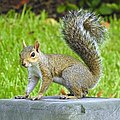 | Eastern United States | |
| Eastern meadow vole | Microtus pennsylvanicus | Cricetidae |  | Northern United States and Mountain States | |
| Eastern mole | Scalopus aquaticus | Scalopinae |  | Eastern United States, Lower Midwest, Southern United States | |
| Eastern red bat | Lasiurus borealis | Vespertilionidae |  | Eastern United States and Midwestern United States | |
| Eastern small-footed myotis | Myotis leibii | Vespertilionidae | | Eastern United States | |
| Eastern wolf | Canis lycaon | Canidae |  | Great Lakes, New England | |
| Elk | Cervus canadensis | Cervidae |  | Contiguous United States | |
| Elliot's short-tailed shrew | Blarina hylophaga | Soricinae |  | Arkansas, Colorado, Iowa, Kansas, Louisiana, Missouri, Nebraska, Oklahoma, Texas | |
| European hare | Lepus europaeus | Leporidae |  | New York (introduced) | |
| European red fox | Vulpes vulpen crucigera | Canidae |  | Across the country (introduced) | |
| Evening bat | Nycticeius humeralis | Vespertilionidae |  | Midwestern and Southern United States | |
| Everglades short-tailed shrew | Blarina peninsulae | Soricinae | | Florida | |
| False killer whale | Pseudorca crassidens | Delphinidae |  | East and West Coast of the United States | |
| Fin whale | Balaenoptera physalus | Balaenopteridae |  | East and West Coast of the United States | |
| Fisher | Pekania pennanti | Mustelidae |  | Alaska, the Appalachians, Great Lakes, New England, Pacific Northwest | |
| Florida bonneted bat | Eumops floridanus | Molossidae |  | Florida | |
| Florida coastal white-tailed deer | Odocoileus virginianus osceola | Cervidae | | Coasts of Alabama, Florida and Mississippi | |
| Florida manatee | Trichechus manatus latirostris | Trichechidae |  | Florida; has been spotted in New England, the Gulf of Mexico and near the confluence of the Wolf and Mississippi rivers in Memphis | The largest sea cow species; The Alabama and Florida state marine mammal |
| Florida panther | Puma concolor coryi | Felidae |  | Florida | The Florida state mammal |
| Florida salt marsh vole | Microtus dukecampbelli | Cricetidae |  | Florida | |
| Florida white-tailed deer | Odocoileus virginianus seminolus | Cervidae |  | Florida | |
| Fog shrew | Sorex sonomae | Soricinae | | California, Oregon | |
| Fox squirrel | Sciurus niger | Sciuridae |  | Eastern and Midwestern United States | |
| Fraser's dolphin | Lagenodelphis hosei | Delphinidae |  | Gulf of Mexico and Florida | |
| Fresno kangaroo rat | Dipodomys nitratoides | Heteromyidae |  | San Joaquin Valley | |
| Fringed myotis | Myotis thysanodes | Vespertilionidae |  | Western United States | |
| Gervais's beaked whale | Mesoplodon europaeus | Ziphiidae |  | East Coast | |
| Ghost-faced bat | Mormoops megalophylla | Mormoopidae |  | South Texas | |
| Giant kangaroo rat | Dipodomys ingens | Heteromyidae |  | California | |
| Ginkgo-toothed beaked whale | Mesoplodon ginkgodens | Ziphiidae |  | California | |
| Glacier Bay water shrew | Sorex alaskanus | Soricinae | | Alaska | |
| Golden-mantled ground squirrel | Callospermophilus lateralis | Sciuridae |  | Western United States | |
| Gray bat | Myotis grisescens | Vespertilionidae |  | East South Central States, Lower Midwest | |
| Gray fox | Urocyon cinereoargenteus | Canidae |  | Across the country | The Delaware state mammal |
| Gray seal | Halichoerus grypus | Phocidae |  | New England | |
| Gray-tailed vole | Microtus canicaudus | Cricetidae | | Washington and Oregon | |
| Gray whale | Eschrichtius robustus | Eschrichtiidae |  | West Coast | The California state marine mammal |
| Great Basin pocket mouse | Perognathus parvus | Heteromyidae |  | Great Basin | |
| Great Plains wolf | Canis lupus nubilus | Canidae |  | Michigan, Minnesota, North Dakota, Wisconsin | |
| Greater bulldog bat | Noctilio leporinus | Noctilionidae |  | Puerto Rico, U.S. Virgin Islans | |
| Greater long-nosed bat | Leptonycteris nivalis | Phyllostomidae |  | Southern Arizona, south New Mexico, South Texas | |
| Grizzly bear | Ursus arctos horribilis | Ursidae |  | Alaska, Pacific Northwest | The Montana state mammal |
| Groundhog | Marmota monax | Sciuridae |  | Alaska, Eastern United States, Idaho | |
| Guadalupe fur seal | Arctocephalus townsendi | Otariidae |  | Channel Islands | |
| Gulf Coast kangaroo rat | Dipodomys compactus | Heteromyidae |  | Texas | |
| Gunnison's prairie dog | Cynomys gunnisoni | Sciuridae |  | Utah, Colorado, Arizona and New Mexico | |
| Haida ermine | Mustela haidarum | Mustelidae |  | Alexander Archipelago | |
| Haida Gwaii black bear | Ursus americanus carlottae | Ursidae |  | Across the country except Hawaii, Puerto Rico and the U.S. Virgin Islands | |
| Hairy-tailed mole | Parascalops breweri | Scalopinae | 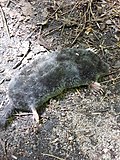 | Northeastern United States; extends into the Mid-South | |
| Hall's pocket gopher | Geomys jugossicularis | Geomyidae | | Colorado, Kansas, and Nebraska | |
| Harbor seal | Phoca vitulina | Phocidae |  | West and East Coast of the United States | The Rhode Island state marine mammal |
| Harbour porpoise | Phocoena phocoena | Phocoenidae |  | The Rhode Island East and West Coast of the United States | |
| Harris's antelope squirrel | Ammospermophilus harrisii | Sciuridae |  | Arizona, New Mexico | |
| Hawaiian hoary bat | Lasiurus semotus | Vespertilionidae |  | Hawaii | The Hawaii state land mammal |
| Hawaiian monk seal | Neomonachus schauinslandi | Phocidae |  | Hawaii | The Hawaii state mammal |
| Heermann's kangaroo rat | Dipodomys heermanni | Heteromyidae |  | California | |
| Hilton Head white-tailed deer | Odocoileus virginianus hiltonensis | Cervidae | | Hilton Head Island | |
| Hispid pocket mouse | Chaetodipus hispidus | Heteromyidae |  | Great Plains | |
| Hoary bat | Lasiurus cinereus | Vespertilionidae |  | Across the country | |
| Hoary marmot | Marmota monax | Sciuridae |  | Alaska, Montana, Washington | |
| Hualapai mexican vole | Microtus mexicanus hualapaiensis | Cricetidae |  | Hualapai Mountains | |
| Hubb's beaked whale | Mesoplodon carlhubbsi | Ziphiidae |  | West Coast | |
| Humboldt's flying squirrel | Glaucomys oregonensis | Sciuridae |  | California, Nevada, Oregon, and Washington | |
| Humpback whale | Megaptera novaeangliae | Balaenopteridae |  | East and West Coast | The Hawaii state marine mammal |
| Hunting Island white-tailed deer | Odocoileus virginianus venatorius | Cervidae | | Hunting Island | |
| Idaho pocket gopher | Thomomys idahoensis | Geomyidae | | Idaho, Montana, Utah, Wyoming | |
| Indiana bat | Myotis sodalis | Vespertilionidae |  | Eastern and Southern United States | |
| Insular flying fox | Pteropus tonganus | Pteropodidae |  | American Samoa | |
| Insular myotis | Myotis insularum | Vespertilionidae | | American Samoa | |
| Insular vole | Microtus abbreviatus | Cricetidae | | St. Matthew Island and Hall Island | |
| Interior Alaskan wolf | Canis lupus pambasileus | Canidae |  | Alaska | |
| Inyo mule deer | Odocoileus hemionus inyoensis | Cervidae |  | Central California | |
| Inyo shrew | Sorex tenellus | Soricinae |  | California, Nevada | |
| Island fox | Urocyon littoralis | Canidae |  | Channel Islands | |
| Jamaican fruit bat | Artibeus jamaicensis | Phyllostomidae |  | Puerto Rico, U.S. Virgin Islands | |
| Kansas white-tailed deer | Odocoileus virginianus macrourus | Cervidae |  | Arkansas, Iowa, Kansas, Louisiana, Missouri, Nebraska, South Dakota and Texas | The Arkansas state mammal |
| Keen's myotis | Myotis keenii | Vespertilionidae |  | Alaska, Washington | |
| Kenai black bear | Ursus americanus perniger | Ursidae | | Kenai Peninsula | |
| Kenai red fox | Vulpes vulpen kenaiensis | Canidae | | Kenai Peninsula | |
| Key deer | Odocoileus virginianus clavium | Cervidae |  | Florida Keys | |
| Kit fox | Vulpes macrotis | Canidae |  | Southwestern United States | |
| Knox Jones's pocket gopher | Geomys knoxjonesi | Geomyidae | | New Mexico and Texas | |
| Kodiak bear | Ursus arctos middendorffi | Ursidae |  | Kodiak Islands | The second largest species of bear after polar bears |
| Kodiak red fox | Vulpes vulpen harrimani | Canidae |  | Kodiak Island | |
| Leach's single leaf bat | Monophyllus redmani | Phyllostomidae |  | Puerto Rico | |
| Least weasel | Mustela nivalis | Mustelidae |  | Alaska, Great Plains, Northeastern United States | |
| Lesser long-nosed bat | Leptonycteris yerbabuenae | Phyllostomidae |  | Southern Arizona, South California, South New Mexico, | |
| Little brown bat | Myotis lucifugus | Vespertilionidae | | Everywhere except Florida, Hawaii, Louisiana, Southwestern United States, Texas | |
| Little pocket mouse | Perognathus longimembris | Heteromyidae |  | Western United States | |
| Long-eared myotis | Myotis evotis | Vespertilionidae |  | Western United States | |
| Long-finned pilot whale | Globicephala melas | Delphinidae |  | East Coast | |
| Long-legged myotis | Myotis volans | Vespertilionidae | 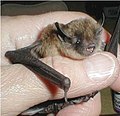 | Western United States | |
| Long-tailed pocket mouse | Chaetodipus formosus | Heteromyidae |  | Arizona, California, Nevada and Utah | |
| Long-tailed shrew | Sorex dispar | Soricinae |  | Northeastern United States | |
| Long-tailed vole | Microtus longicaudus | Cricetidae |  | Western United States | |
| Long-tailed weasel | Neogale frenata | Mustelidae |  | The Contiguous United States | |
| Louisiana black bear | Ursus americanus luteolus | Ursidae |  | East Texas, Louisiana and Mississippi | |
| Lower Keys marsh rabbit | Sylvilagus palustris hefneri | Leporidae |  | Florida Keys | |
| Manitoban elk | Cervus canadensis manitobensis | Cervidae |  | North Carolina, North Dakota | |
| Mariana fruit bat | Pteropus mariannus | Pteropodidae |  | Guam, the Northern Mariana Islands | |
| Marsh rabbit | Sylvilagus palustris | Leporidae | 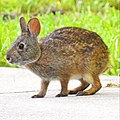 | Florida; coasts of the Carolinas | |
| Marsh shrew | Sorex bendirii | Soricinae |  | West Coast | |
| Mazama pocket gopher | Thomomys mazama | Geomyidae |  | Pacific Northwest | |
| Melon-headed whale | Peponocephala electra | Delphinidae |  | Gulf of Mexico | |
| Merriam's kangaroo rat | Dipodomys merriami | Heteromyidae |  | Southwestern United States | |
| Merriam's pocket mouse | Perognathus merriami | Heteromyidae |  | New Mexico, Oklahoma, Texas | |
| Merriam's shrew | Sorex merriami | Soricinae |  | Western United States | |
| Mexican fox squirrel | Sciurus nayaritensis | Sciuridae |  | Arizona | |
| Mexican free-tailed bat | Tadarida brasiliensis | Molossidae |  | Southern United States, Southwestern United States | The Oklahoma and Texas state flying mammal |
| Mexican gray squirrel | Sciurus aureogaster | Sciuridae |  | Florida Keys (introduced) | |
| Mexican ground squirrel | Ictidomys mexicanus | Sciuridae |  | New Mexico and Texas | |
| Mexican spiny pocket mouse | Heteromys irroratus | Heteromyidae |  | South Texas | |
| Mexican wolf | Canis lupus baileyi | Canidae |  | Arizona, New Mexico | |
| Miller's long-tongued bat | Glossophaga longirostris | Phyllostomidae |  | U.S. Virgin Islands | |
| Minor red bat | Lasiurus minor | Vespertilionidae | | Puerto Rico | |
| Montane shrew | Sorex monticolus | Soricinae |  | Alaska, Western United States | Texas state flying mammal |
| Montane vole | Microtus montanus | Cricetidae |  | Western United States | |
| Moose | Alces alces | Cervidae |  | Alaska, Idaho, New England, New York, North Dakota, Oregon, the Rockies, Upper Peninsula of Michigan, Washington, Wisconsin, Wyoming | The tallest, largest and heaviest species of deer and the tallest and second largest mammal in North America; The Alaska state land mammal and the Maine state mammal |
| Mount Graham red squirrel | Tamiasciurus fremonti grahamensis | Sciuridae | 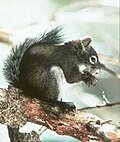 | Pinaleño Mountains | |
| Mount Lyell shrew | Sorex lyelli | Soricinae | | Mount Lyell | |
| Mountain beaver | Aplodontia rufa | Aplodontiidae |  | California, Nevada, Oregon and Washington | |
| Mountain cottontail | Sylvilagus nuttallii | Leporidae |  | Western United States | |
| Mountain goat | Oreamnos americanus | Bovidae |  | Alaska, Colorado, Idaho, Montana, Nevada, Oregon, South Dakota, Utah, Washington, Wyoming | |
| Mountain pocket gopher | Thomomys monticola | Geomyidae |  | California and Nevada | |
| Mule deer | Odocoileus hemionus | Cervidae |  | Western United States | |
| Muskox | Ovibos moschatus | Bovidae |  | Alaska | |
| Narrow-faced kangaroo rat | Dipodomys venustus | Heteromyidae |  | California | |
| Nelson's collared lemming | Dicrostonyx nelsoni | Cricetidae |  | Alaska | |
| Nelson's pocket mouse | Chaetodipus nelsoni | Heteromyidae |  | New Mexico and Texas | |
| New England cottontail | Sylvilagus transitionalis | Leporidae |  | New England | |
| New Mexico black bear | Ursus americanus altifrontalis | Ursidae |  | Arizona, Colorado, New Mexico, Utah and West Texas | |
| New Mexico shrew | Sorex neomexicanus | Soricinae | | New Mexico | |
| Nine-banded armadillo | Dasypus novemcinctus | Dasypodidae |  | Southern United States | The only species of armadillo that inhabits the United States; The Texas state small mammal |
| North American beaver | Castor canadensis | Castoridae |  | Across the contiguous United States | The New York and Oregon state mammal |
| North American cougar | Puma concolor couguar | Felidae |  | Western United States | |
| North American least shrew | Cryptotis parva | Soricinae | 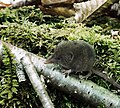 | Central United States, Eastern United States | |
| North American porcupine | Erethizon dorsatum | Erethizontidae |  | Alaska, Contiguous United States except the South | |
| North American river otter | Lontra canadensis | Mustelidae |  | Alaska, Eastern United States, Northern California, Pacific Northwest | |
| North American water vole | Microtus pinetorum | Cricetidae | | Northwestern United States | |
| North Atlantic humpback whale | Megaptera novaeangliae novaeangliae | Balaenopteridae |  | East Coast | |
| North Atlantic minke whale | Balaenoptera acutorostrata acutorostrata | Balaenopteridae | | East Coast | |
| North Atlantic right whale | Eubalaena glacialis | Balaenidae |  | East Coast | The Georgia and Massachusetts state marine mammal and the South Carolina state migratory marine mammal |
| North Pacific fin whale | Balaenoptera physalus velifera | Balaenopteridae |  | West Coast | |
| North Pacific humpback whale | Megaptera novaeangliae kuzira | Balaenopteridae |  | West Coast | |
| North Pacific minke whale | Balaenoptera acutorostrata scammoni | Balaenopteridae | | West Coast | |
| North Pacific right whale | Eubalaena japonica | Balaenidae |  | Alaska | |
| Northern Alaskan red fox | Vulpes vulpen alascensis | Canidae |  | Yukon Delta National Wildlife Refuge | |
| Northern blue whale | Balaenoptera musculus musculus | Balaenopteridae |  | Alaska, New England, West Coast | |
| Northern bog lemming | Synaptomys borealis | Cricetidae | | Alaska, Idaho, Maine, Montana, New Hampshire, Vermont and Washington | |
| Northern bottlenose whale | Hyperoodon ampullatus | Ziphiidae |  | New England | |
| Northern broad-footed mole | Scapanus latimanus | Scalopinae |  | California, Nevada, Oregon | |
| Northern collared lemming | Dicrostonyx groenlandicus | Cricetidae |  | Alaska | |
| Northern elephant seal | Mirounga angustirostris | Phocidae |  | Alaska, West Coast, Northern Mariana Islands | |
| Northern fin whale | Balaenoptera physalus physalus | Balaenopteridae |  | East Coast and West Coast of the United States | |
| Northern flying squirrel | Glaucomys sabrinus | Sciuridae |  | Alaska, the Appalachians, Great Lakes, New England, and Western United States | |
| Northern fur seal | Callorhinus ursinus | Otariidae |  | Alaska, West Coast | |
| Northern long-eared bat | Myotis septentrionalis | Vespertilionidae |  | Eastern United States | |
| Northern plains red fox | Vulpes vulpen regalis | Canidae |  | Elk River | |
| Northern pocket gopher | Thomomys monticola | Geomyidae |  | Northwestern United States | |
| Northern red-backed vole | Clethrionomys rutilus | Cricetidae |  | Alaska | |
| Northern right whale dolphin | Lissodelphis borealis | Delphinidae |  | West Coast | |
| Northern short-tailed shrew | Blarina brevicauda | Soricinae | 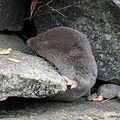 | Central United States, Eastern United States | |
| Northern white-tailed deer | Odocoileus virginianus borealis | Cervidae |  | Northeastern United States | The Illinois, New Hampshire, Ohio, Pennsylvania and Wisconsin state mammal and the Michigan state game mammal |
| Northern yellow bat | Lasiurus intermedius | Vespertilionidae |  | Gulf Coast | |
| Northwestern white-tailed deer | Odocoileus virginianus ochrourus | Cervidae | | Western United States | |
| Northwestern wolf | Canis lupus occidentalis | Canidae |  | Alaska, Northwestern United States | |
| Nutria | Myocastor coypus | Echimyidae |  | Contiguous United States (introduced) | |
| Ocelot | Leopardus pardalis | Felidae |  | Arizona and Texas | |
| Olived-backed pocket mouse | Perognathus fasciatus | Heteromyidae |  | Great Plains | |
| Olympic black bear | Ursus americanus altifrontalis | Ursidae |  | Pacific Northwest | |
| Olympic marmot | Marmota olympus | Sciuridae |  | Olympic National Park | |
| Olympic shrew | Sorex rohweri | Soricinae | | Olympic National Park | |
| Orca | Orcinus orca | Delphinidae |  | East and West Coast of the United States | The Washington state marine mammal |
| Ord's kangaroo rat | Dipodomys ordii | Heteromyidae |  | The Great Plains and the Great Basin | |
| Oregon pronghorn | Antilocapra americana oregona | Antilocapridae | 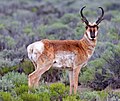 | Oregon | |
| Ornate shrew | Sorex ornatus | Soricinae |  | California | |
| Ozark big-eared bat | Corynorhinus townsendii ingens | Vespertilionidae |  | Arkansas, Missouri and Oklahoma | |
| Pacific common seal | Phoca vitulina richardii | Phocidae |  | West Coast | |
| Pacific marten | Martes caurina | Mustelidae |  | Western United States | |
| Pacific sheath-tailed bat | Emballonura semicaudata | Emballonuridae |  | American Samoa, Guam | |
| Pacific shrew | Sorex pacificus | Soricinae |  | Oregon | |
| Pacific white-sided dolphin | Lagenorhynchus acutus | Delphinidae |  | West Coast | |
| Pale kangaroo mouse | Microdipodops pallidus | Heteromyidae |  | California and Nevada | |
| Pallid bat | Antrozous pallidus | Vespertilionidae | 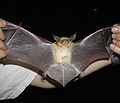 | Western United States | The state bat of California |
| Panamint kangaroo rat | Dipodomys panamintus | Heteromyidae |  | The Mojave Desert | |
| Pantropical spotted dolphin | Stenella attenuata | Delphinidae |  | East Coast | |
| Parnell's moustached bat | Pteronotus parnellii portoricensis | Mormoopidae |  | Puerto Rico | |
| Perrin's beaked whale | Mesoplodon perrini | Ziphiidae |  | California | |
| Philippine deer | Rusa marianna | Cervidae |  | Guam, the Northern Mariana Islands | |
| Plains bison | Bison bison bison | Bovidae |  | Alaska, Arizona and Montana | |
| Plains pocket gopher | Geomys bursarius | Geomyidae |  | Great Plains | |
| Plains pocket mouse | Perognathus flavescens | Heteromyidae |  | Central and Western United States | |
| Pocketed free-tailed bat | Nyctinomops femorosaccus | Molossidae |  | Arizona, California, New Mexico, Texas | |
| Polar bear | Ursus maritimus | Ursidae |  | Arctic Alaska | The largest bear species |
| Porcupine caribou | Rangifer arcticus arcticus | Cervidae |  | Alaska | |
| Prairie shrew | Sorex haydeni | Soricinae |  | Midwestern United States | |
| Prairie vole | Microtus ochrogaster | Cricetidae |  | Central United States | |
| Preble's shrew | Sorex preblei | Soricinae | | Great Basin | |
| Pribilof Island shrew | Sorex hydrodromus/pribilofensis | Soricinae | | Pribilof Islands | |
| Pronghorn | Antilocapra americana | Antilocapridae |  | Arizona, Colorado, Idaho, Kansas, Montana, Nebraska, Nevada, New Mexico, North Dakota, Northern California, Oklahoma, Oregon, South Dakota, Texas, Utah, Washington and Wyoming | Τhe fastest land mammal in the Western Hemisphere |
| Pygmy killer whale | Feresa attenuata | Delphinidae |  | East Coast | |
| Pygmy rabbit | Brachylagus idahoensis | Leporidae | 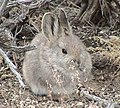 | Great Basin | The world's smallest rabbit |
| Pygmy sperm whale | Kogia breviceps | Kogiidae |  | East and West Coast of the United States | |
| Raccoon | Procyon lotor | Procyonidae |  | Across the country except Alaska, Hawaii, Puerto Rico and the U.S. Virgin Islands | The Tennessee state mammal and the Oklahoma state furbearer |
| Rafinesque's big-eared bat | Corynorhinus rafinesquii | Vespertilionidae |  | Southeastern United States | |
| Red fox | Vulpes vulpen | Canidae |  | Across the country except Hawaii, Puerto Rico and the U.S. Virgin Islands | |
| Red fruit bat | Stenoderma rufum | Phyllostomidae | | Puerto Rico, U.S. Virgin Islands | |
| Red tree vole | Arborimus longicaudus | Cricetidae |  | California and Oregon | |
| Red wolf | Canis rufus | Canidae |  | Southeastern United States | |
| Reindeer | Rangifer tarandus | Cervidae |  | Alaska, Idaho, Montana and Washington | |
| Rhesus macaque | Macaca mulatta | Cercopithecidae |  | Florida, South Carolina, Puerto Rico | |
| Ribbon seal | Histriophoca fasciata | Phocidae |  | Alaska | |
| Rice's whale | Balaenoptera ricei | Balaenopteridae |  | Gulf of Mexico | |
| Ringed seal | Pusa hispida | Phocidae |  | Alaska, New England | |
| Ringtail | Bassariscus astutus | Procyonidae |  | Southwestern United States, West South Central states | The Arizona state mammal |
| Rio Grande ground squirrel | Ictidomys parvidens | Sciuridae |  | New Mexico and Texas | |
| Risso's dolphin | Grampus griseus | Delphinidae |  | East and West Coast of the United States | |
| Robust cottontail | Sylvilagus holzneri | Leporidae |  | Arizona, New Mexico, West Texas | |
| Rock pocket mouse | Chaetodipus intermedius | Heteromyidae |  | Southwestern United States | |
| Rock vole | Microtus chrotorrhinus | Cricetidae |  | The Appalachians and New England | |
| Rocky Mountains bighorn sheep | Ovis canadensis canadensis | Bovidae |  | The Rockies and Northwestern United States | The Colorado state mammal |
| Rocky Mountain elk | Cervus canadensis nelsoni | Cervidae |  | The Rockies | The Utah state mammal |
| Rocky Mountains mule deer | Odocoileus hemionus hemionus | Cervidae |  | The Rockies | |
| Roosevelt elk | Cervus canadensis roosevelti | Cervidae |  | Kodiak Archipelago, Pacific Northwest | |
| Rough-toothed dolphin | Steno bredanensis | Delphinidae |  | East and West Coast of the United States | |
| Sagebrush vole | Lemmiscus curtatus | Cricetidae |  | Western United States | |
| Saint Lawrence Island shrew | Sorex jacksoni | Soricinae | | St. Lawrence Island | |
| Samoa flying fox | Pteropus samoensis | Pteropodidae |  | American Samoa | |
| San Joaquin antelope squirrel | Ammospermophilus nelsoni | Sciuridae |  | San Joaquin Valley | |
| San Joaquin kit fox | Vulpes macrotis mutica | Canidae |  | Central California | |
| San Joaquin pocket mouse | Perognathus inornatus | Heteromyidae |  | California | |
| Sand Hills pocket gopher | Geomys lutescens | Geomyidae | | Colorado, Nebraska, South Dakota, and Wyoming | |
| Sea otter | Enhydra lutris | Mustelidae |  | Alaska, the West Coast | |
| Sei whale | Balaenoptera borealis | Balaenopteridae |  | East and West Coast of the United States | |
| Selkirk Mountains caribou | Rangifer arcticus montanus | Cervidae | 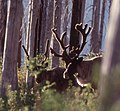 | Idaho, Montana, Washington | |
| Seminole bat | Lasiurus seminolus | Vespertilionidae |  | Southern United States | |
| Short-finned pilot whale | Globicephala macrorhynchus | Delphinidae |  | East and West Coast of the United States | |
| Sierra Nevada bighorn sheep | Ovis canadensis sierrae | Bovidae |  | The Sierra Nevada | |
| Sierra Nevada red fox | Vulpes vulpen necator | Canidae |  | The Cascades and the Sierra Nevada | |
| Silky pocket mouse | Perognathus flavus | Heteromyidae | 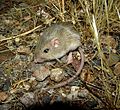 | Southwestern United States | |
| Silver-haired bat | Lasionycteris noctivagans | Vespertilionidae |  | Across the country except Hawaii, Puerto Rico and the U.S. Virgin Islands | |
| Singing vole | Microtus miurus | Cricetidae | 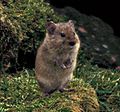 | Alaska | |
| Sitka black-tailed deer | Odocoileus hemionus sitkensis | Cervidae |  | Alaskan Panhandle | |
| Smoky shrew | Sorex fumeus | Soricinae |  | Northeastern United States | |
| Snowshoe hare | Lepus americanus | Leporidae |  | Alaska, the Appalachians, the Cascades, Michigan, Minnesota, New England, the Rockies, the Sierra Nevada, Wisconsin | |
| Sonoma tree vole | Arborimus pomo | Cricetidae | | Northern California | |
| Sonoran pronghorn | Antilocapra americana sonoriensis | Antilocapridae |  | Sonoran Desert | |
| Sooty mustached bat | Pteronotus quadridens | Mormoopidae | | Puerto Rico | |
| Southeastern myotis | Myotis austroriparius | Vespertilionidae |  | Gulf Coast, Mid-South (region) | |
| Southeastern pocket gopher | Geomys pinetis | Geomyidae |  | Alabama, Georgia, and Florida | |
| Southeastern shrew | Sorex longirostris | Soricinae |  | Southeastern United States | |
| Southern bog lemming | Synaptomys cooperi | Cricetidae |  | Eastern and Midwestern United States | |
| Southern broad-footed mole | Scapanus occultus | Scalopinae | | California | |
| Southern flying squirrel | Glaucomys volans | Sciuridae |  | Eastern United States | |
| Southern mule deer | Odocoileus hemionus fuliginatus | Cervidae |  | Southern California | |
| Southern pocket gopher | Thomomys umbrinus | Geomyidae |  | Arizona, New Mexico | |
| Southern red-backed vole | Clethrionomys gapperi | Cricetidae |  | Alaska, Arizona, Colorado, Delaware, Idaho, Kentucky, Maryland, Michigan, Minnesota, Montana, New England, New Jersey, New Mexico, New York, North Carolina, North Dakota, Oregon, Pennsylvania, South Dakota, Tennessee, Utah, Virginia, Washington, West Virginia, Wisconsin and Wyoming | |
| Southern short-tailed shrew | Blarina carolinensis | Soricinae |  | Southern United States, Illinois | |
| Southern yellow bat | Lasiurus ega | Vespertilionidae |  | Lower Rio Grande Valley | |
| Southwestern myotis | Myotis auriculus | Vespertilionidae |  | Arizona, New Mexico | |
| Southwestern red squirrel | Tamiasciurus fremonti | Sciuridae |  | Western United States | |
| Sowerby's beaked whale | Mesoplodon bidens | Ziphiidae |  | New England | |
| Sperm whale | Physeter macrocephalus | Physeteridae |  | East and West Coast of the United States | The Connecticut state mammal |
| Spinner dolphin | Stenella longistrosis | Delphinidae |  | East Coast | |
| Spiny pocket mouse | Chaetodipus spinatus | Heteromyidae |  | Arizona, California and Nevada | |
| Spotted bat | Euderma maculatum | Vespertilionidae |  | Western United States | |
| Spotted seal | Phoca largha | Phocidae |  | Alaska | |
| Squirrel monkey | Saimiri sciureus | Cebidae |  | Florida, Puerto Rico | |
| Star-nosed mole | Condylura cristata | Scalopinae |  | Atlantic Coast, Great Lakes, New England | |
| Stejneger's beaked whale | Mesoplodon stejnegeri | Ziphiidae |  | West Coast of the United States | |
| Steller sea lion | Eumetopias jubatus | Otariidae |  | Alaska, West Coast | The largest eared seal |
| Stephen's kangaroo rat | Dipodomys stephensi | Heteromyidae | 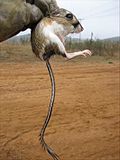 | Southern California | |
| Stoat | Mustela erminea | Mustelidae |  | Alaska, the Dakotas, Great Lakes, New England, Northeastern United States, and the Western United States (excluding Arizona, Nevada, New Mexico and South California) | |
| Stone's caribou | Rangifer arcticus stone | Cervidae | | Alaska | |
| Strecker's pocket gopher | Geomys streckeri | Geomyidae | | Texas | |
| Striped dolphin | Stenella coeruleoalba | Delphinidae |  | East and West Coast of the United States | |
| Swamp rabbit | Sylvilagus aquaticus | Leporidae |  | Southern United States | |
| Swift fox | Vulpes velox | Canidae |  | Colorado, Kansas, Montana, New Mexico, Oklahoma and Texas | |
| Taiga vole | Microtus xanthognathus | Cricetidae |  | Alaska | |
| Texas antelope squirrel | Ammospermophilus interpres | Sciuridae |  | Texas, New Mexico | |
| Texas kangaroo rat | Dipodomys elator | Heteromyidae |  | Oklahoma, Texas | |
| Texas pocket gopher | Geomys personatus | Geomyidae |  | Texas | |
| Texas white-tailed deer | Odocoileus virginianus texanus | Cervidae |  | Colorado, Kansas, Nebraska, New Mexico, Oklahoma, Texas and Wyoming | The Nebraska state mammal and Oklahoma state game mammal |
| Thirteen-lined ground squirrel | Ictidomys tridecemlineatus | Sciuridae |  | Great Plains | |
| Townsend's big-eared bat | Corynorhinus townsendii | Vespertilionidae |  | Western United States | |
| Townsend's mole | Scapanus townsendii | Scalopinae |  | Coastal Pacific Northwest | The largest North American mole |
| Townsend's pocket gopher | Thomomys townsendii | Geomyidae |  | Northwestern United States | |
| Townsend's vole | Microtus townsendii | Cricetidae |  | Oregon and Washington | |
| Tricolored bat | Perimyotis subflavus | Vespertilionidae |  | Midwestern and Southern United States | |
| True's beaked whale | Mesoplodon mirus | Ziphiidae |  | East Coast | |
| Trowbridge's shrew | Sorex trowbridgii | Soricinae |  | Pacific Coast | |
| Tule elk | Cervus canadensis nannodes | Cervidae |  | California | |
| Tundra shrew | Sorex tundrensis | Soricinae |  | Alaska | |
| Unalaska collared lemming | Dicrostonyx unalascensis | Cricetidae | | Umnak and Unalaska | |
| Underwood's bonneted bat | Eumops underwoodi | Molossidae | | Arizona | |
| Utah prairie dog | Cynomys parvidens | Sciuridae |  | Utah | |
| Vagrant shrew | Sorex vagrans | Soricinae |  | Western United States | |
| Velvety free-tailed bat | Molossus molossus | Molossidae |  | Florida Keys, Puerto Rico | |
| Virginia big-eared bat | Corynorhinus townsendii virginianus | Vespertilionidae |  | Kentucky, North Carolina, Virginia and West Virginia | The Virginia state bat |
| Virginia opossum | Didelphis virginiana | Didelphidae |  | Eastern United States, Lower Midwest, Pacific Coast (introduced), Southern United States | The only marsupial that inhabits the United States; The North Carolina state marsupial |
| Virginia white-tailed deer | Odocoileus virginianus virginianus | Cervidae | | Southeastern United States except Florida | The Georgia, Mississippi and South Carolina state mammal |
| Walrus | Odobenus rosmarus | Odobenidae |  | Alaska | |
| Wasatch Mountains red fox | Vulpes vulpen macroura | Canidae |  | Colorado, Idaho, Montana, Utah, Wyoming | |
| Western gray squirrel | Sciurus griseus | Sciuridae |  | Western United States | |
| Western heather vole | Phenacomys intermedius | Cricetidae | | Western United States | |
| Western mastiff bat | Eumops perotis | Molossidae |  | Southwestern United States | |
| Western meadow vole | Microtus drummondii | Cricetidae |  | Midwestern and Western United States | |
| Western red-backed vole | Clethrionomys californicus | Cricetidae |  | California and Oregon | |
| Western red bat | Lasiurus frantzii | Vespertilionidae |  | Western United States | |
| Western small-footed myotis | Myotis ciliolabrum | Vespertilionidae |  | Great Plains, Western United States | |
| Western yellow bat | Lasiurus xanthinus | Vespertilionidae |  | Southwestern United States | |
| White-beaked dolphin | Lagenorhynchus albirostris | Delphinidae |  | New England | |
| White-eared pocket mouse | Perognathus alticola | Heteromyidae | | Southern California | |
| White-footed vole | Arborimus albipes | Cricetidae | | Northwestern United States | |
| White-sided jackrabbit | Lepus callotis | Leporidae |  | New Mexico | |
| White-tailed antelope squirrel | Ammospermophilus leucurus | Sciuridae |  | Southwestern United States | |
| White-tailed deer | Odocoileus virginianus | Cervidae |  | Contiguous United States | |
| White-tailed jackrabbit | Lepus townsendii | Leporidae |  | Upper Midwest and Western United States | |
| White-tailed prairie dog | Cynomys leucurus | Sciuridae |  | Utah, Colorado, Wyoming and Montana | |
| Wolf | Canis lupus | Canidae |  | Across the country except Hawaii, Puerto Rico and the U.S. Virgin Islands | |
| Wolverine | Gulo gulo | Mustelidae |  | Alaska; has been in various states of the West | The largest mustelid |
| Woodland vole | Microtus pinetorum | Cricetidae |  | Eastern United States | |
| Wyoming pocket gopher | Thomomys clusius | Geomyidae |  | Wyoming | |
| Yellow-bellied marmot | Marmota flaviventris | Sciuridae |  | Western United States | |
| Yellow-faced pocket gopher | Cratogeomys castanops | Geomyidae |  | Southwestern United States | |
| Yuma myotis | Myotis yumanensis | Vespertilionidae |  | Western United States | |
